The New DELE A2 Exam Format

Good news for all who need to pass the DELE A2 exam! From the February 2020 sitting the new DELE A2 exam has an improved, updated format. The (slight) changes don’t affect the core curriculum and the assessment criteria. These still conform to the CEFR (the common European framework for languages). The format, however, has been streamlined and somewhat shortened. The topics covered in the exam tasks are now also more relevant to the everyday life experiences and needs of a prospective immigrant to Spain.
OVERVIEW:
The Instituto Cervantes (which administers the exam) has said that, whereas in the past the exam was aimed mostly at people studying Spanish for academic or professional reasons, the fact that the DELE A2 “has been established as a requirement for applicants of Spanish nationality who do not have Spanish as their mother tongue, it was necessary to review and update the functioning of the exam for this new profile of candidates”.
The exam still tests the four communication skills, namely reading and listening comprehension, plus written and oral expression. However, there are now fewer tasks in each of the four components, with fewer questions per task, which are all now more focused on “familiar everyday topics”. The new DELE A2 exam includes some of the features of other CEFR exams such as the Cambridge English – for example, in having sample questions & answers at the beginning of sections to help candidates better understand what is required.
The new exam still starts of with reading comprehension, with a duration of 60 minutes. This now consists of four tasks (previously 5) containing 25 questions (instead of the 30 of the old exam format). Thematically, it’s built around “everyday topics familiar to a broader profile of users”. (Once we’ve briefly covered the general exam framework for the four skills in this initial overview, we will go into detail about the new specifications for each skill section, showing illustrative extracts from a new model A2 exam).
The listening comprehension test lasts 40 minutes, and also has seen its tasks reduced to four (from 5) with 25 questions. The pauses between audio clips have been lengthened, and each task is illustrated with a sample question & answer at its start. Thematically, the questions now also cover familiar everyday topics.
The written expression test has been reduced from three to two tasks, with the time reduced from 50 to 45 minutes. The first task is to write a replying e-mail. The second requires writing a descriptive text of 70 to 80 words, for which a choice is given between two topics related to everyday life.
The oral expression test has been reduced from four to three tasks, with an overall duration of 12 minutes of talking (plus 12 minutes preparation time allowed). Here as well, the questions relate to familiar everyday topics. The first task is still a brief monologue, relating to a personal circumstance (chosen from two options, and prepared beforehand). The second task involves describing a photo reflective of a common public situation. The 3rd task is a conversation between the candidate and the examiner, about the photograph in task two.
From the above, you can see that the improved exam is now shorter, as well as being better illustrated (to make it easier to understand what to do), plus being focused more on familiar everyday topics than on academic or professional language needs. The standards have not been lowered, but because the exam has been better targeted with more relevant questions, it should actually prove easier.
The same “can do” skills have to be mastered as before, with the focus strongly on truly understanding the message of what you read and hear, plus being able to express yourself understandably: with coherence, accuracy, fluency and with an ample lexis (vocabulary, as well as cohesive link phrases, plus expressions / collocations).
Even more than before, this exam is about you can DO, much more than about what you may abstractly know in the academic sense (in other words, it is very different from your typical school or college language exam!).
We will now look more closely at how each of the four communicative skills are being tested, illustrating with extracts from the official exam specifications (translated for your convenience) and with screen grabs of the new model exam which the Instituto Cervantes has now posted on its website. You can access the complete model exam (including answer keys and transcripts of the audio clips) via this link:
https://examenes.cervantes.es/a1a2/pdf/a2/A2R_modelo0_completo.pdf
You can also read the Institute’s one-page summary of the changes, in English, by clicking on this link:
https://examenes.cervantes.es/a1a2/a2_en.htm
If you feel up to reading the official A2 DELE exam specifications in academic Spanish, you can do so here (we will provide a translation of the key points below):
https://examenes.cervantes.es/a1a2/pdf/a2/Especificaciones_%20examen_DELE_A2_v2020.pdf
The new DELE A2 exam Prueba 1 – the Reading Comprehension Test:
The first task of Prueba 1 of the new DELE A2 consists of 5 questions. It has as goal to test your ability to capture the central idea and to identify specific information of an uncomplicated and evident nature, in short texts such as e-mails, letters and the like. The format is multiple choice, selecting the right answer to each question from three options.
Task 2 of Prueba 1 tests, with 8 questions, whether you can identify and understand key ideas and information of a descriptive nature contained in brief informative texts such as notices, adverts, instructions, advisories and the like, each 50 – 60 words in length. Again the format is 3-option multiple choice. Here’s what the illustrative example in the model exam looks like:
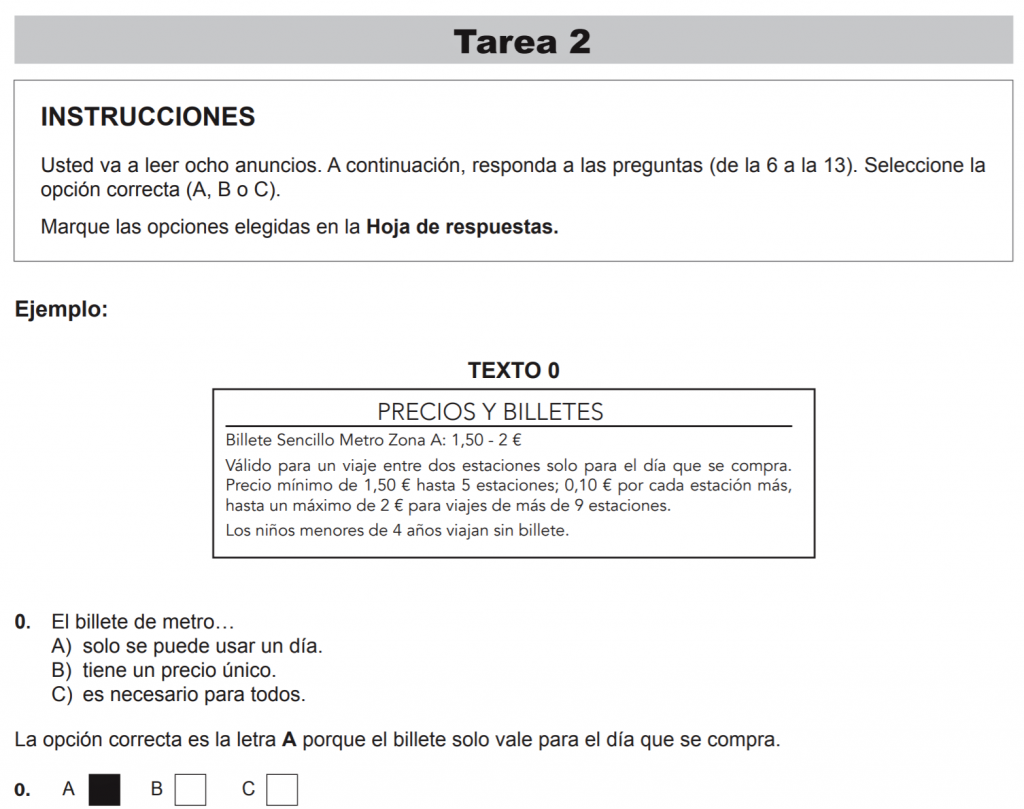
The third reading task has 6 questions. It builds on the theme of task 2, namely of identifying relevant information from texts, this time of 100 – 120 words in length, lifted from newspaper articles, blogs, job offers and such. Three texts are provided, and six statements or questions must be paired with their corresponding texts.
The fourth task of 6 questions involves identifying essential ideas and theme changes contained in narrative texts of 375 – 425 words. The texts are lifted from biographies, articles and stories and contain narrations about persons, places and events. The right answer must be chosen from three options given for each of the 6 questions.
The new DELE A2 exam Prueba 2 – the Listening Comprehension Test:
The first listening task consists of 6 questions (each with three multiple choice options) which test your ability to understand key ideas in informal face-to-face type conversations about everyday activities such as hobbies, tastes and interests plus transactional exchanges in shops, restaurants and the like. Here’s the illustrative sample from the model exam, plus its transcript:

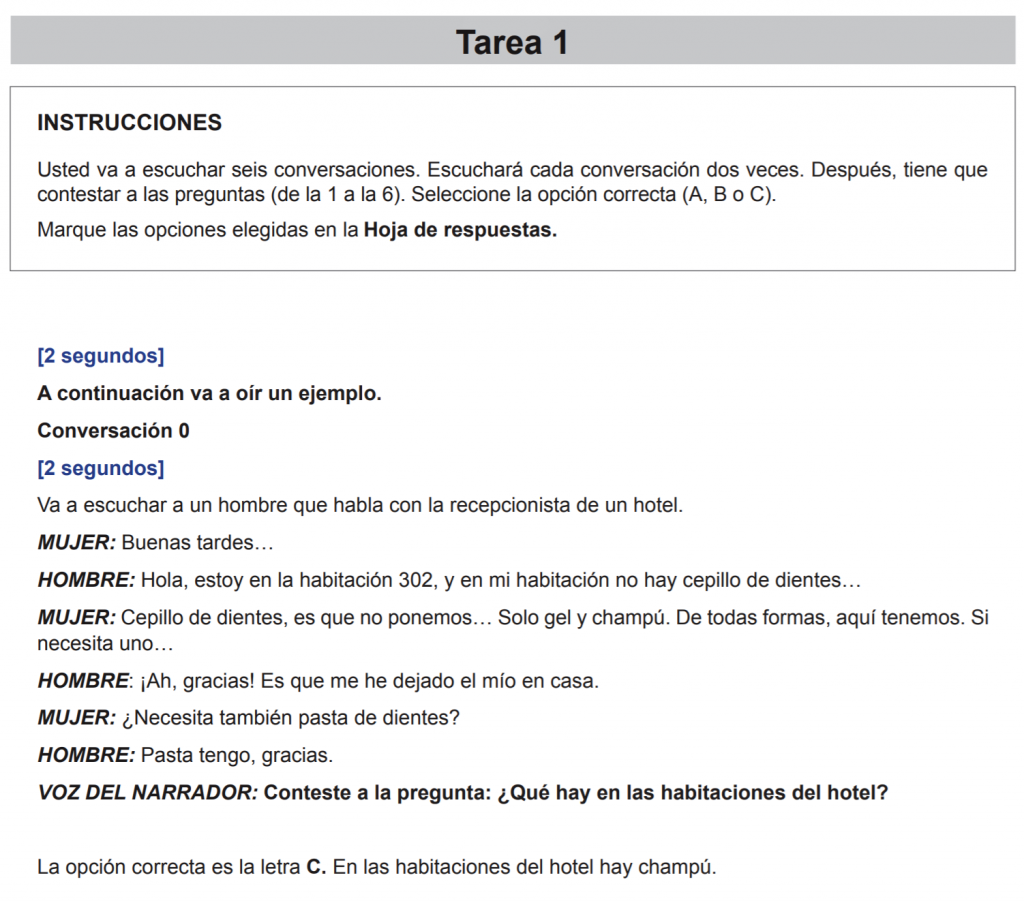
The 2nd listening task (6 multiple choice questions) tests whether you can capture the general idea from broadcasts that are articulated slowly and clearly. The clips are informative in nature, such as news, announcements, adverts etc.
The 3rd task tests whether you can correctly identify information from everyday conversations. It also consists of 6 questions, but requires pairing of statements with the person who uttered them. Here’s the illustrative sample question:
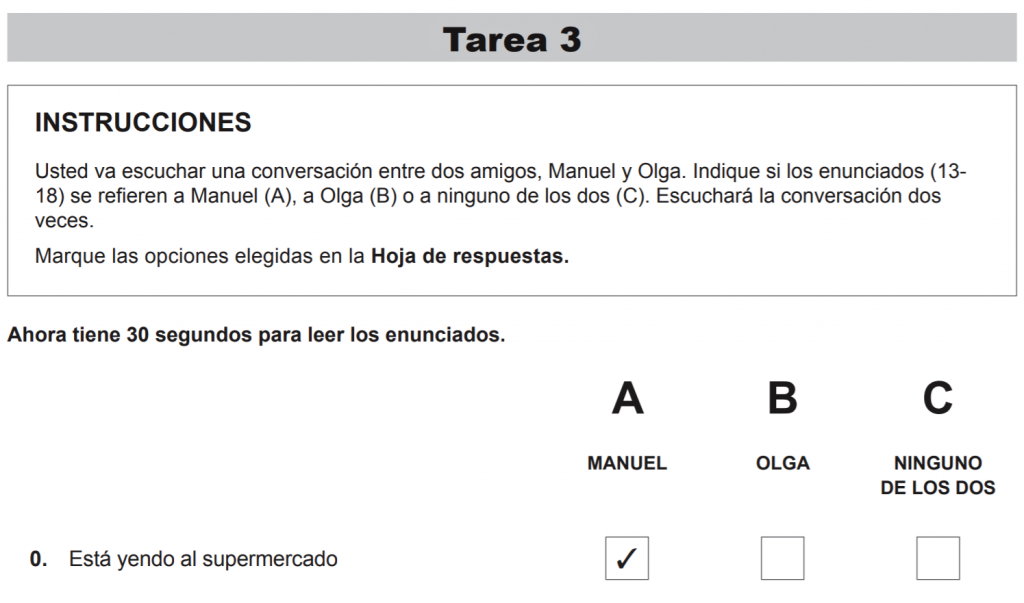
The fourth listening task of 7 questions tests whether you can understand public announcements (emitted over P.A. systems or radio) regarding everyday situations. There are seven audio clips to listen to (eight with the sample question), and you must pair the correct announcement to 7 of the ten options given. Here’s the sample question:
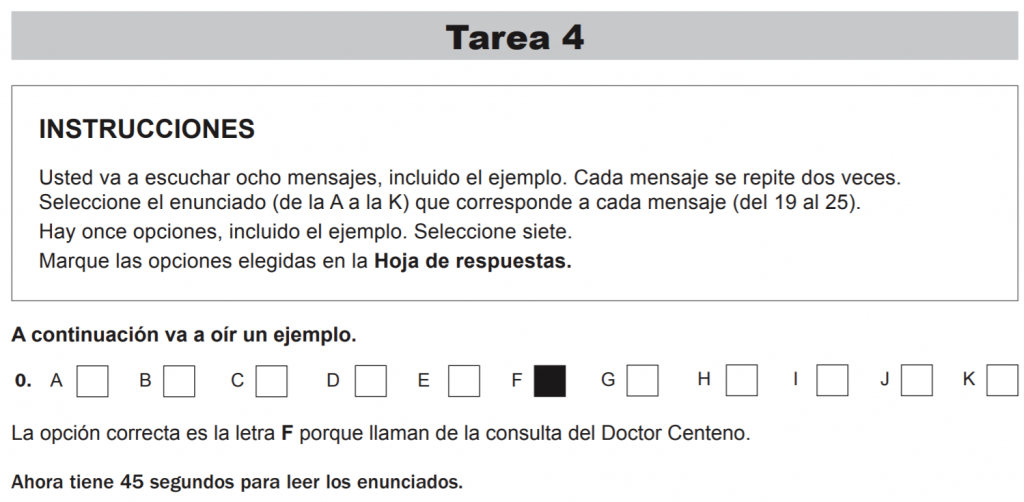
SPECIAL OFFER – FREE DELE EXAM PREP WORKBOOK: For guidance on how to ace the DELE exam’s comprehension tests (such as the examiners’ use of “distractors”), ask for our gratis, no obligation sample DELEhelp e-book of 96 pages WB#9.2: “DELE / SIELE exam Orientation and Acing Tips“. It is a comprehensive guide to understanding the exam’s goals, curriculum, format and assessment criteria. You can ask for it by using our quick contact info form, which you can access by clicking on the image below:

The new DELE A2 exam Prueba 3 – The Expression in Writing Test:
The new DELE A2 exam writing test consists of two tasks. The first task is to write a personal missive, in the form of an e-mail, letter or card of 60 – 70 words in length, about everyday situations. The task is in reality to draft a response to such a missive that you’ve received from someone else, as can be seen from the illustrative sample:

The 2nd task entails writing a narrative text of 70 – 80 words, chosen from two options. It tests ability to express yourself coherently in cohesive (i.e., flowing and interconnected) writing, with sufficiently ample linguistic scope and accurate language use. The topics are of an everyday nature related to the candidate’s personal sphere of knowledge. Here’s the sample question:

The new DELE A2 exam Prueba 4 – the Oral Expression Test:
The new DELE A2 oral exam (i.e., testing your ability to actually speak Spanish) now consists of three tasks. The objective is to demonstrate that you can be understood: that you are coherent and fluent (able to use cohesive devices and link phrases), that you possess a sufficiently broad lexis of vocabulary and expressions and that you can use Spanish accurately, i.t.o. pronunciation and grammar.
The first task is a short monologue of 2 – 3 minutes, for which you are given time to prepare beforehand. You must choose between two options, both of which will relate to topics within your personal sphere of knowledge or experience. You can make notes as you prepare and can use these as memory joggers during your presentation, but you may not read verbatim from your notes, complete phrases that you have written down. During your monologue you will not be interrupted. Here’s an example of a typical monologue option:
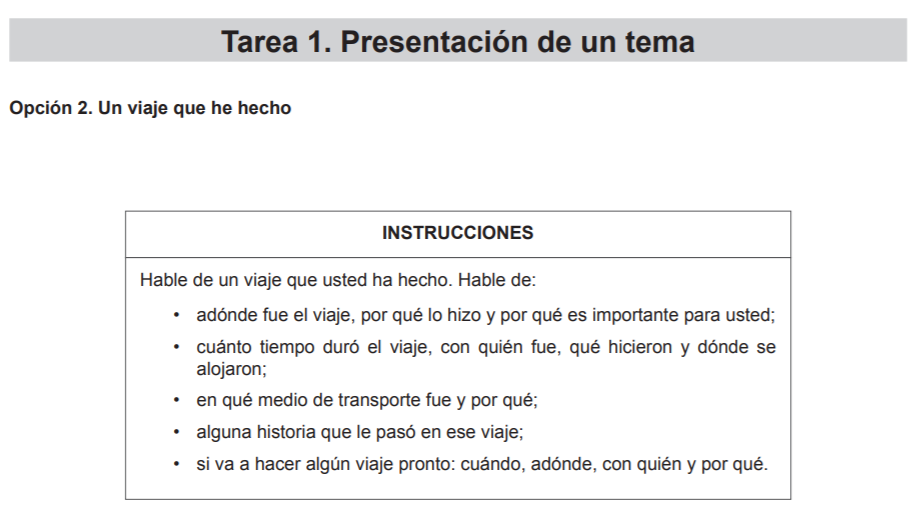
The second task in the new DELE A2 exam involves another short uninterrupted monologue of 2 – 3 minutes, consisting of describing a photograph elected from two offered. The candidate is again provided time to prepare beforehand, and can make & use notes, but not read verbatim from them. This is what the task typically looks like:
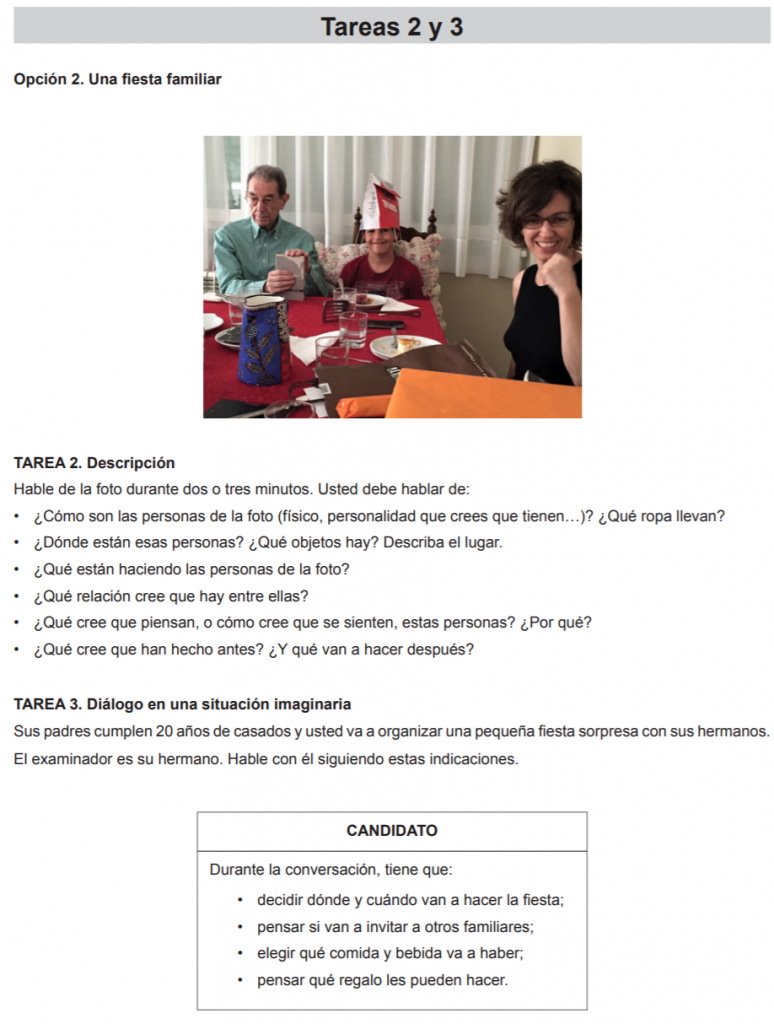
As can be seen, the 3rd oral task follows on and is related to the photograph described in task two. It consists of a conversation of 3 – 4 minutes with the interviewing examiner (in the example above, a role-play where the examiner simulates being your brother, and the two of you discussing how to plan the family celebration). Here’s an example of the type of questions that the examiner can ask, to trigger the conversation:
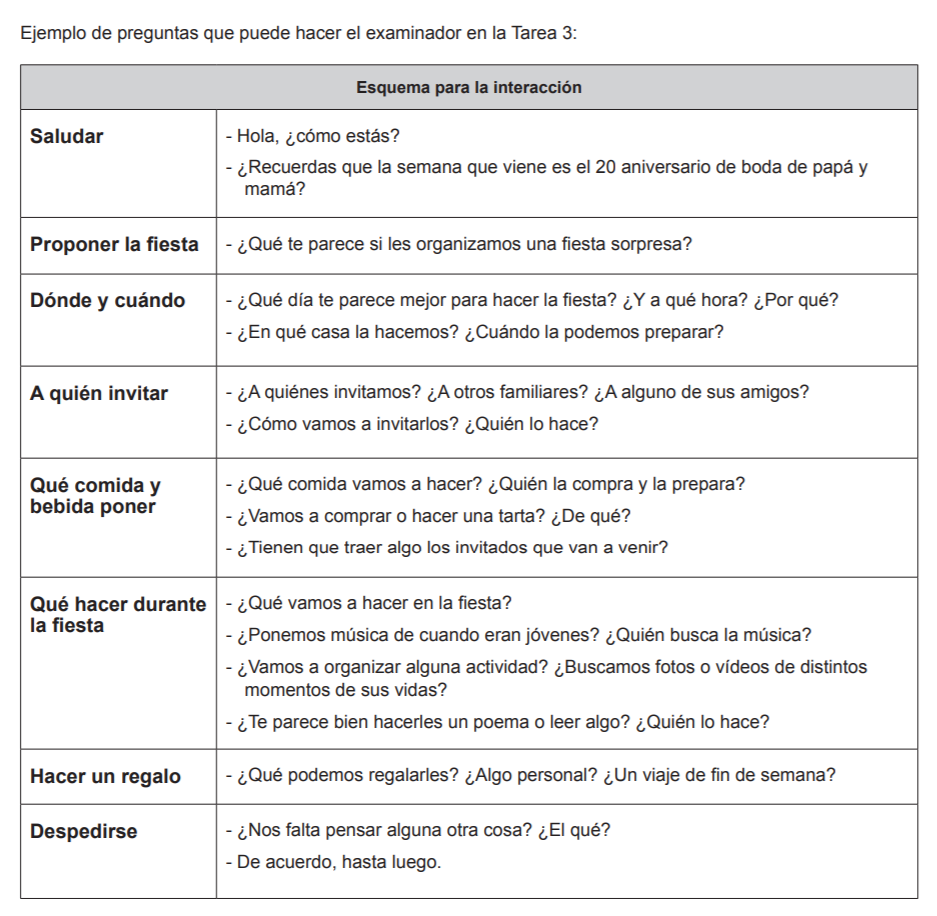
Conclusion – better targeted (thus “easier”) BUT it requires lots of practiced, real-world “can do” ability.
The improved new DELE A2 exam format has better focused the exam on the everyday reference sphere of the typical immigrant. It is relevant and easier to understand (considering that the exam paper is entirely in Spanish).
The emphasis is even more on testing your actual communicative competency (which is the key issue for the CEFR) rather than merely testing what you abstractly know about the Spanish language. Can you effectively use it in real life situations, to understand what you read and hear, and to make yourself understood when you speak or write?
It is a proven fact that communicative ability is first and foremost a SKILL, not just a knowledge set. In addition to what you have to learn (such as new lexis and the patterns or grammar of Spanish), like any other skill, coherent and fluent communication is mastered only through practice, practice and more PRACTICE. To be optimally efficient, this practice needs to be expertly guided.
This is especially true for the expression testing. For writing practice, you need expert feed-back. Also keep in mind that, statistically, 70% of those who fail the DELE, do so because of having failed the oral. Speaking practice is the one thing that’s truly difficult to do effectively on your own, at home. You need an expert coach, 1-on-1, who can engage with and guide you.
Fortunately, modern tech such as Skype and Zoom makes it possible to prepare for all aspects of your new DELE A2 exam with your experienced DELEhelp coach, from the comfort of your own home, at only US$18 per hour, all inclusive. Please look at our website: https://edele.org for more details – you will see that we are official coordinators of our local accredited SIELE exam center (the DELE’s new online twin) as well as being proctors for its American equivalent, the OPIc.
I myself have “been there, done it” in the sense that I hold the DELE C2 diploma – so, our experience of the DELE is from both the candidate’s and the supervisor’s angle.
Remember that we offer a free, no-obligation exploratory Skype session of one hour, during which I explain the new DELE A2 exam’s format, goals and assessment criteria in English, and answer all your questions. You can ask to have this free session set up by using the short contact info form accessed by clicking the image offering the free workbook, above.
I look forward to speaking with you soon!
Buena suerte with your exam prep.
Salu2
Willem
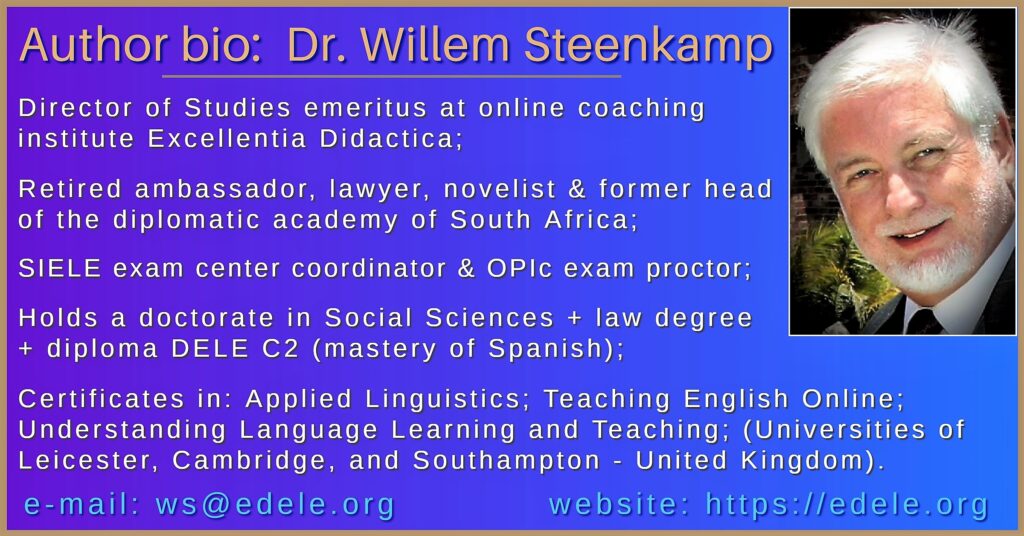


Hi,
I’d like to have some sample tests for DELE -A2 (2020).
They aren’t very easy to find on the web apart this one.
Could I have some websites, pdf.. for exercising ?
Thanks a lot for the help.
Best regards.
Valentina Gagliardi
Hola Valentina – There are excellent resources now available for the new Level A2, such as the ModeloExamenDele e-book of exam papers from Bubok Publishers and the softcover print version published by EDELSA: here are links:
https://www.bubok.es/libros/227710/Nuevo-Examen-DELE-A2-VERSION-2020
https://www.amazon.com/Preparacion-DELE-A2-Libro-CD/dp/8477116342/ref=sr_1_2?ie=UTF8&qid=1520305419&sr=8-2&keywords=EDELSA+A2
Salu2
Willem